Analysis of Water Resources and Water Environmental Carrying Capacity of Animal Husbandry in China—Based on Water Footprint Theory
Abstract
:1. Introduction
2. Materials and Methods
2.1. Animal Husbandry Water Footprint and Carrying Capacity
2.1.1. Animal Husbandry Water Footprint
2.1.2. Animal Husbandry Water Resources Carrying Capacity
2.2. Animal Husbandry Water Environment Bearing Pressure
2.2.1. Animal Husbandry Gray Water Footprint
2.2.2. Animal Husbandry Water Environment Bearing Pressure
2.3. Dagum Gini Coefficient
2.4. Data Sources
3. Results and Discussion
3.1. Temporal and Spatial Differences in the Water Resource Carrying Capacity
3.1.1. Animal Husbandry Water Footprint
3.1.2. Animal Husbandry Water Resource Carrying Capacity
3.2. Spatiotemporal Analysis of the Water Environment Bearing Pressure
3.2.1. Animal Husbandry Gray Water Footprint
3.2.2. Animal Husbandry Water Environment Bearing Pressure
3.3. Discussion
4. Conclusions
Author Contributions
Funding
Institutional Review Board Statement
Informed Consent Statement
Data Availability Statement
Conflicts of Interest
References
- Meng, X. Study on Prevention Problem of China Livestock Environment Pollution; Huazhong Agricultural University: Wuhan, China, 2014. [Google Scholar]
- Liu, G.; Luo, Q.; Zhang, L. The Development of Animal Husbandry Since 40 Years of Reform and Opening-up: Achievements, Challenges and Countermeasures. Chin. Rural Econ. 2018, 12, 19–36. [Google Scholar]
- Ministry of Ecological Environment of the People’s Republic of China, National Bureau of Statistics, Ministry of Agriculture and Rural Areas of the People’s Republic of China. Bulletin of the Second National Survey of Pollution Sources; Ministry of Ecological Environment of the People’s Republic of China, National Bureau of Statistics, Ministry of Agriculture and Rural Areas of the People’s Republic of China: Beijing, China, 2020.
- Wu, Z.; Upmanu, L.; Wang, Z.; Tian, Z. Regional Disparity of Water Footprint in China in the Production Perspective: The Analytical Framework of “Amount-Structure-Efficiency”. China Popul. Resour. Environ. 2015, 25, 85–94. [Google Scholar]
- Di Martino, M.; Avraamidou, S.; Cook, J.; Pistikopoulos, E.N. An optimization framework for the design of reverse osmosis desalination plants under food-energy-water nexus considerations. Desalination 2021, 503, 114937. [Google Scholar] [CrossRef]
- Vanessa, N.; Ramón, A.; Octavio, R.; Munizaga, J.; Sáez, K.; Arumí, J.L. Sustainability assessment of the agricultural water footprint in the Cachapoal River basin, Chile. Ecol. Indic. 2019, 98, 19–28. [Google Scholar]
- Andrei, J.V.; Gogonea, R.-M.; Zaharia, M.; Patrascu, A.; Bălăcescu, A.; Ladaru, R. A Critical Approach on Using Total Water Footprint of Agricultural Products as a Potential Sustainable Development Indicator. Teh. Vjesn. 2020, 27, 671–679. [Google Scholar]
- Wahba, S. Understanding internal water footprint inequality of the Egyptian households based on different income and lifestyles. J. Clean. Prod. 2020. prepublish. [Google Scholar]
- GómezLlanos, E.; MatíasSánchez, A.; DuránBarroso, P. Wastewater Treatment Plant Assessment by Quantifying the Carbon and Water Footprint. Water 2020, 12, 3204. [Google Scholar] [CrossRef]
- Wang, X.; Huang, K.; Yang, S.; Wang, Z.; Hu, T. Temporal Variability and Influencing Factors of Sectoral Water Footprint in China. J. Nat. Resour. 2014, 29, 2114–2126. [Google Scholar]
- Deng, G. Water Footprint Research on Supply Side and Demand Side of Various Industries in China: Based on a World Input-output Model. Stat. Decis. 2021, 37, 73–77. [Google Scholar]
- Pan, A.; Chen, L. Decoupling and Water Footprint Analysis of the Coordinated Development Between Water Utilization and the Economy in Hubei. Resour. Sci. 2014, 36, 328–333. [Google Scholar]
- Shang, Q.; Yin, K.; Mi, W. Assessing water resources in Qinghai province based on theory of water footprint. J. Arid Land Resour. Environ. 2020, 34, 70–77. [Google Scholar]
- Sun, S.; Wang, Y.; Wu, P.; Zhao, X. Spatial variability and attribution analysis of water footprint of wheat in China. Trans. Chin. Soc. Agric. Eng. 2015, 31, 142–148. [Google Scholar]
- Shi, L.; Wu, P.; Wang, Y.; Sun, S.K.; Liu, J. Assessment of water stress in Shaanxi Province based on crop water footprint. Chin. J. Eco-Agric. 2015, 23, 650–658. [Google Scholar]
- Yu, W.; Zhang, H.; Hu, H. Water Resources Carrying Capacity of Livestock Husbandry in China Based on Water Footprint Theory. Resour. Sci. 2012, 34, 394–400. [Google Scholar]
- Hou, X. Water Footprint and Influence Factors of Livestock Husbandry in Jilin Province; Northeast Agricultural University: Haerbin, China, 2016. [Google Scholar]
- Huang, D.; Yang, H. A Study on Water Use of Xinjiang Animal Husbandry Development from the Perspective of Water Footprint. Water Sav. Irrig. 2018, 4, 96–104. [Google Scholar]
- Cheng, J.; Qin, L.; Hou, X. The Space-time Disparity and Optimal Distribution of Water Footprint of Pig Industry in Jilin Province. Chin. Agric. Sci. Bull. 2019, 35, 126–134. [Google Scholar]
- Meng, X.; Zhang, J.; Li, P. Analyze on Spatial-temporal Characteristics of Livestock Husbandry Resources and Environment Pressure in China. Res. Agric. Mod. 2012, 33, 556–560. [Google Scholar]
- Zhang, H.; Zhou, D. China’s regional Disparities and Convergence Evolution of Regional Innovation Level from the Perspective of Innovative Value Chain—Empricical Study Based on Dagum’s Gini Coefficient Decomposition and Spatial Markov Chain. RD Manag. 2016, 28, 48–60. [Google Scholar]
- Dagum, C. A new Approach to the Decomposition of the Gini Income Inequality Ratio. Empir. Econ. 1997, 22, 515–531. [Google Scholar] [CrossRef]

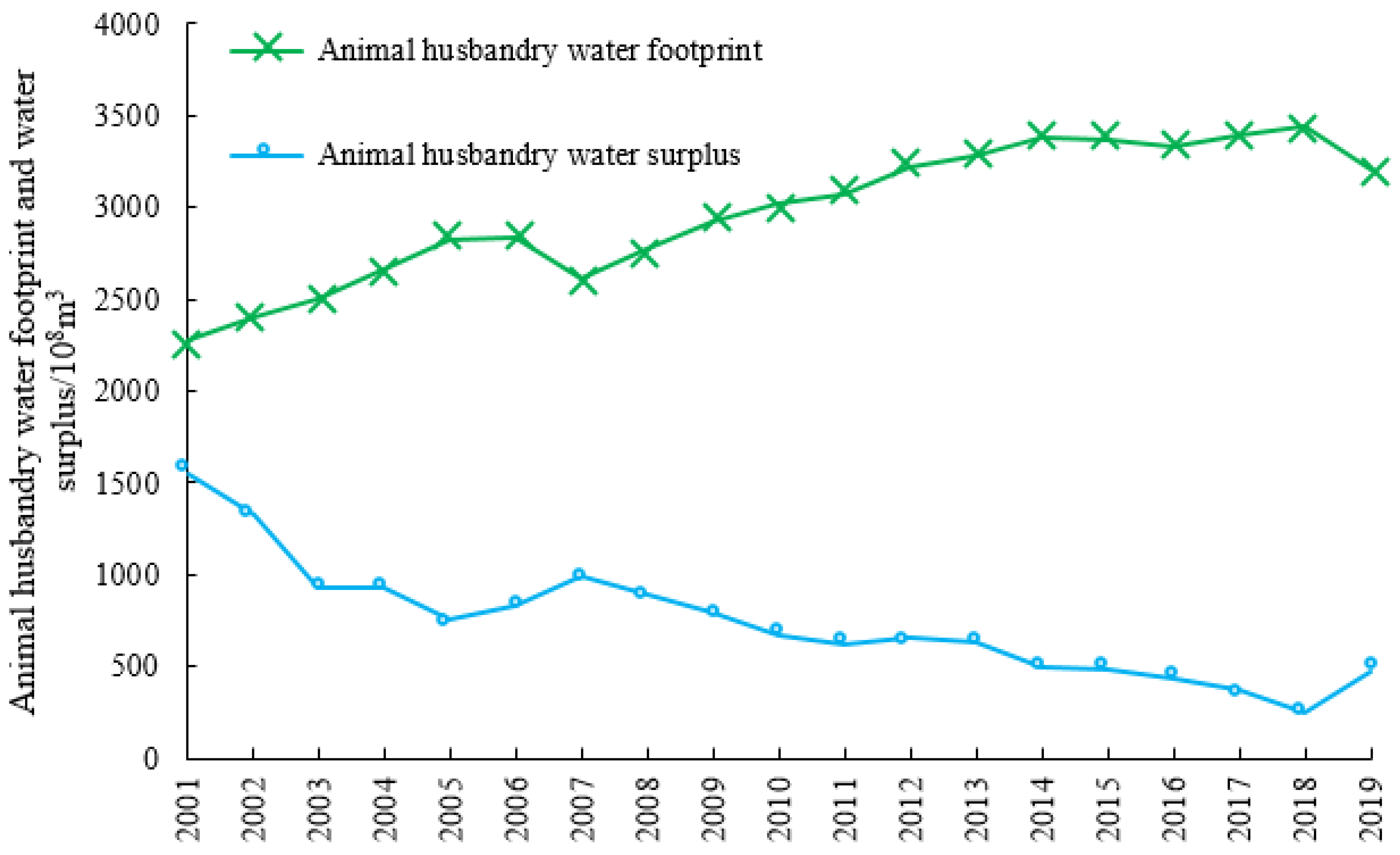
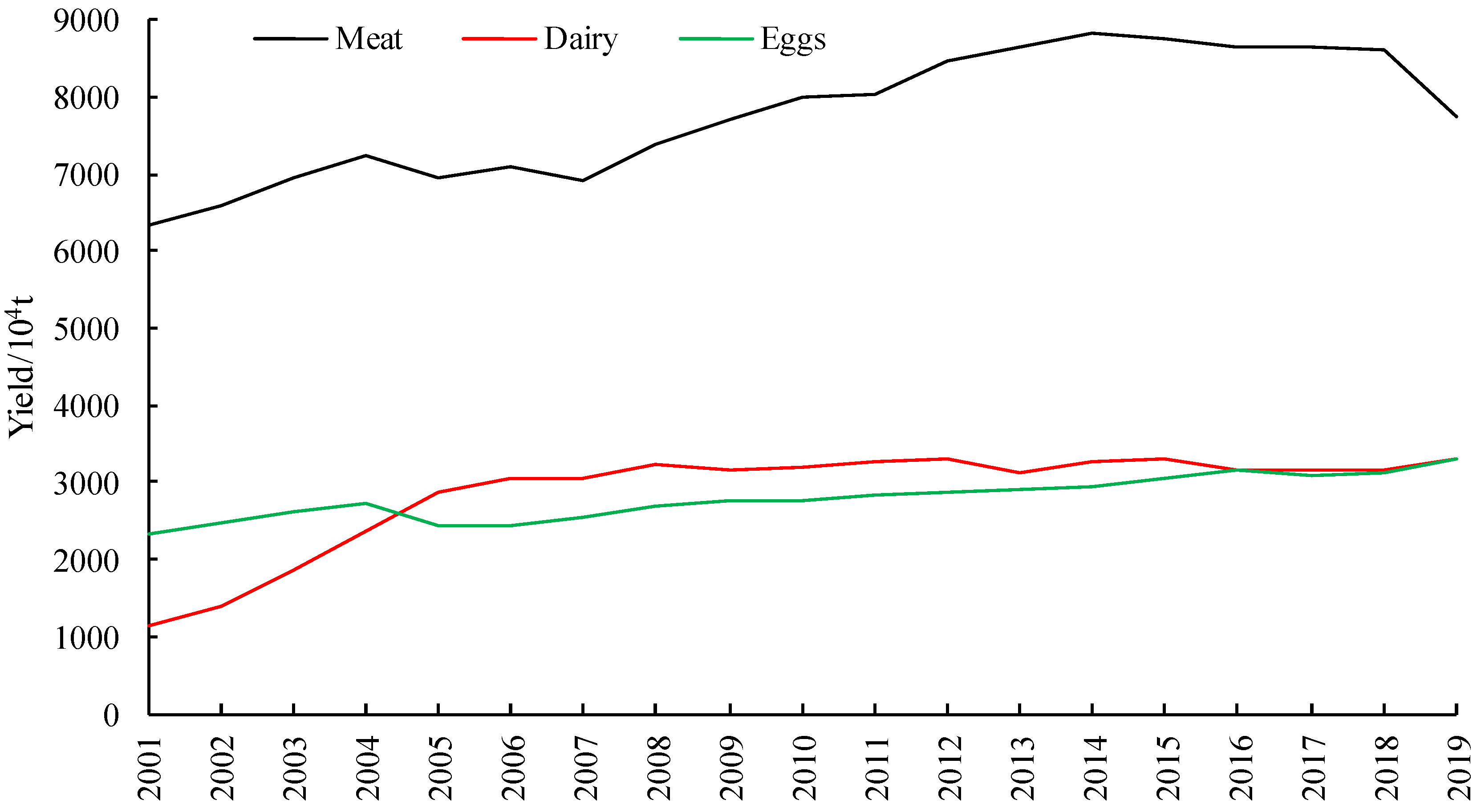
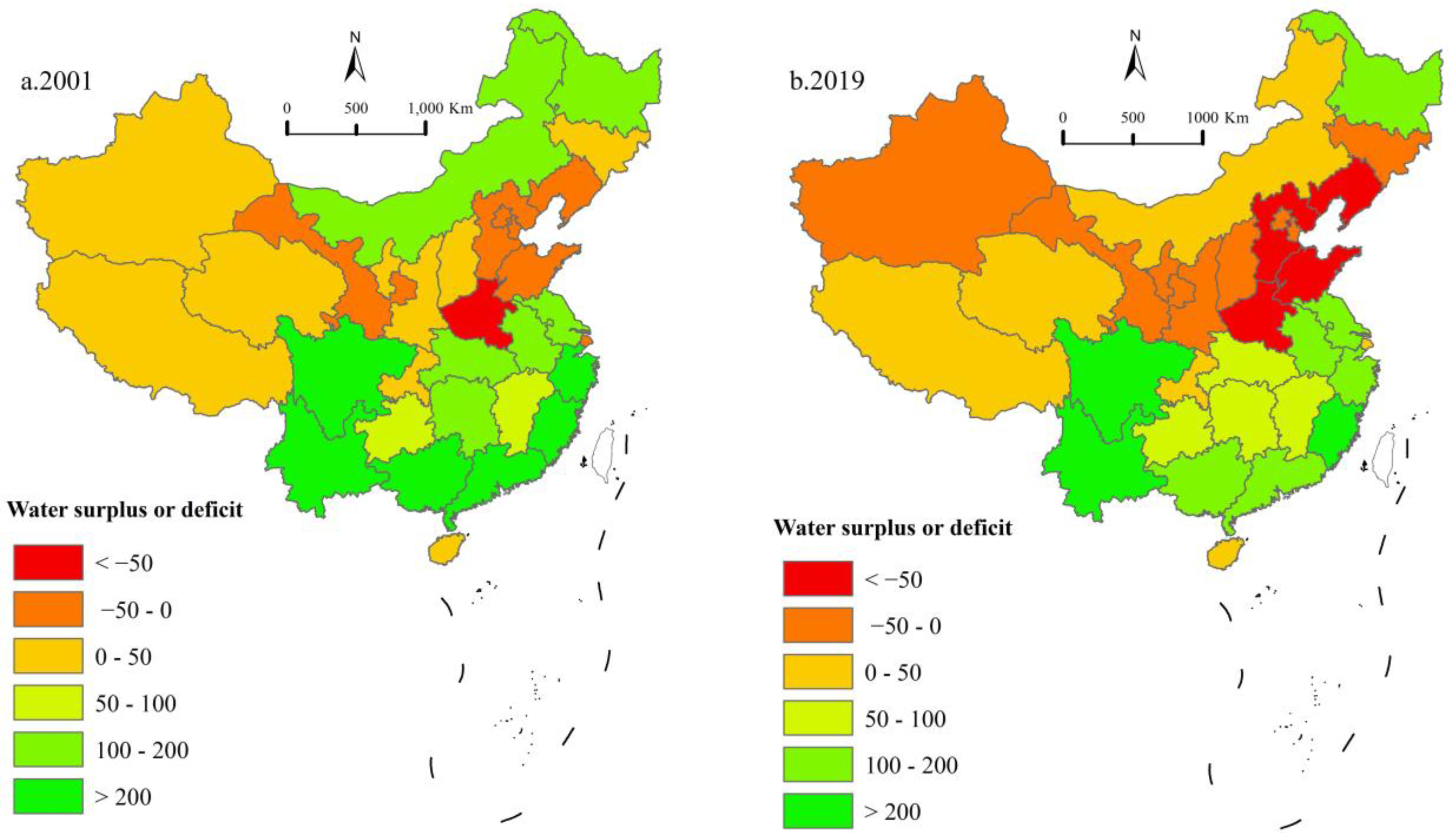
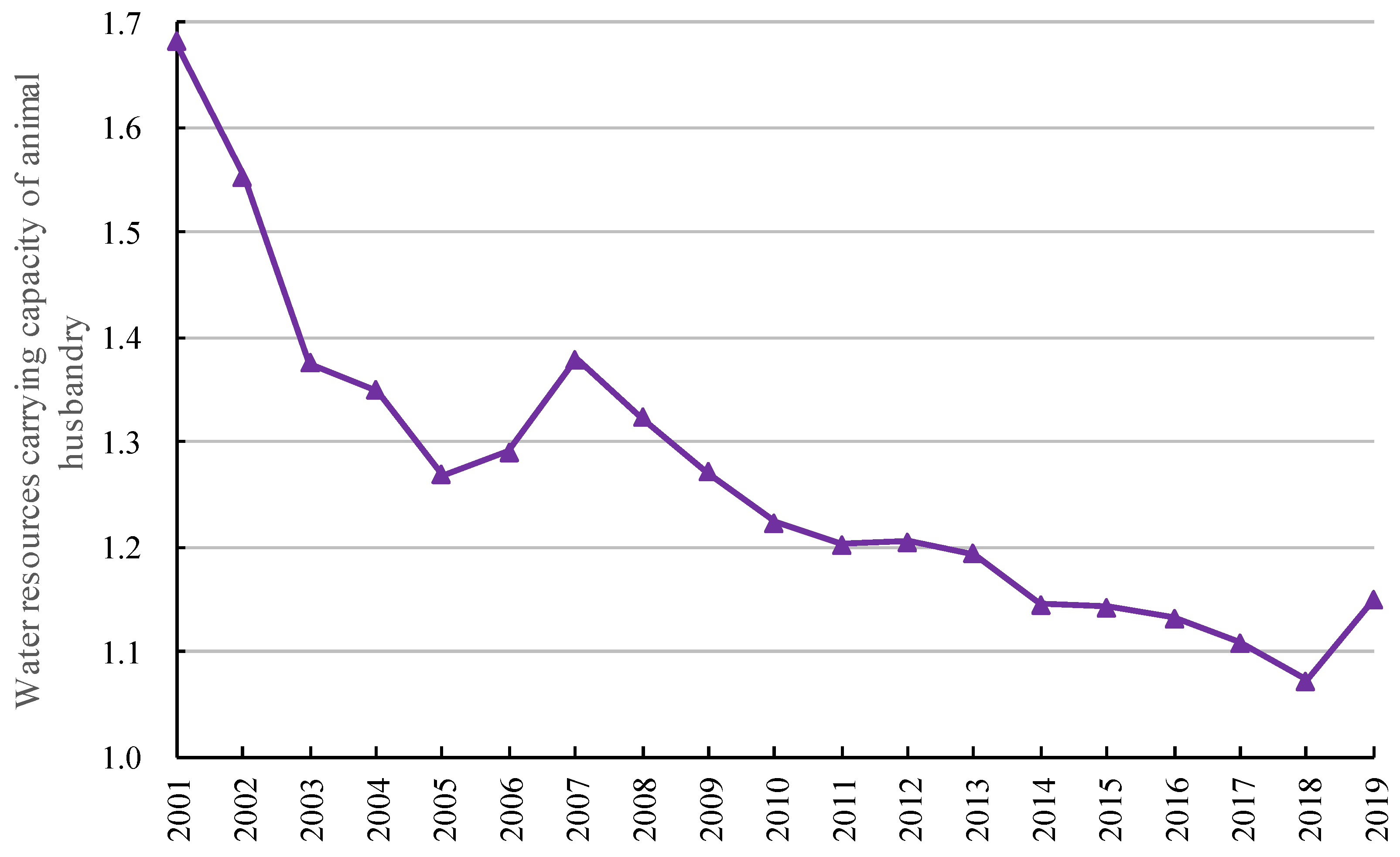
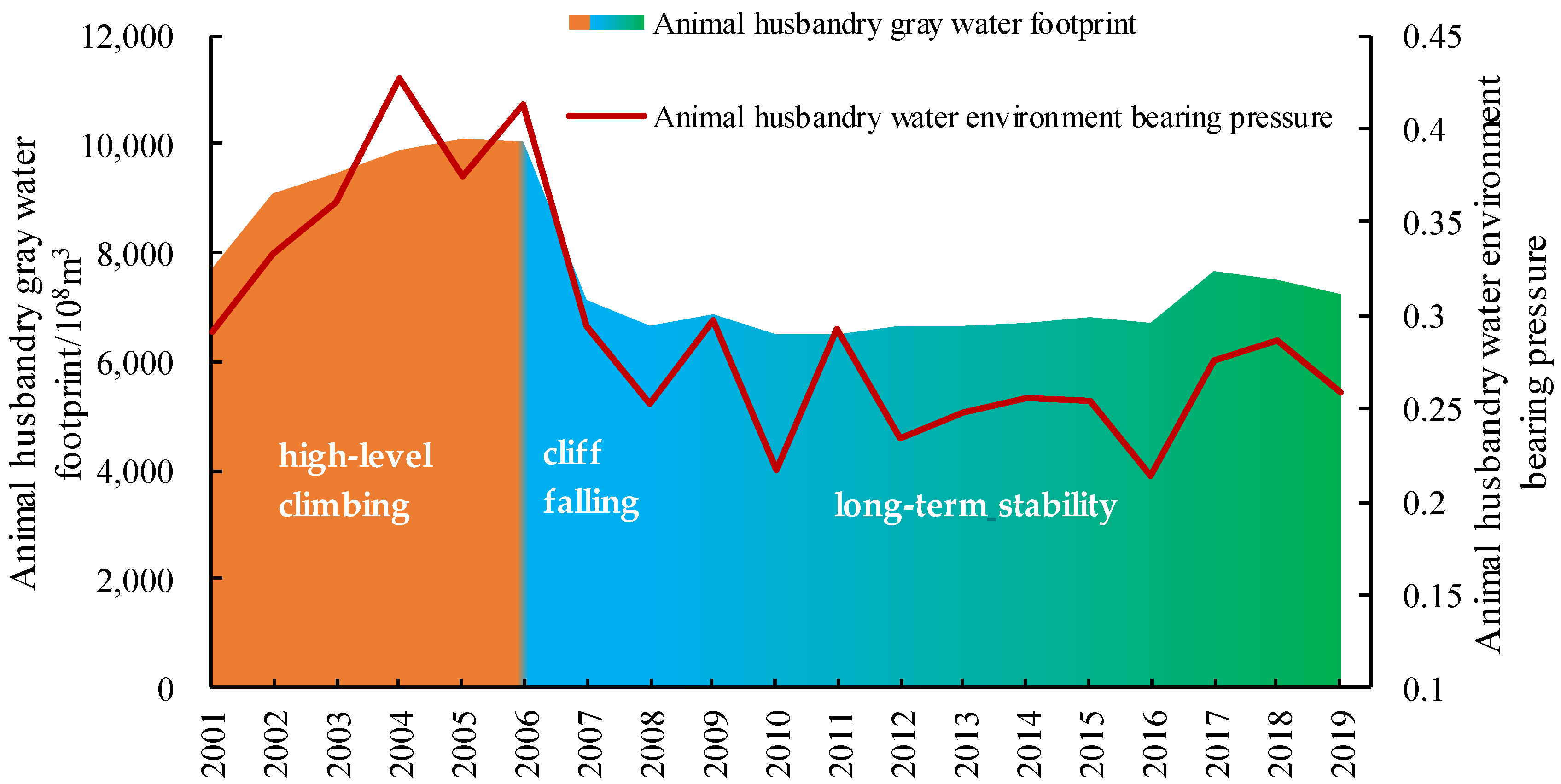
| Region | Type | COD/g·Day−1 | Region | Type | COD/g·Day−1 |
|---|---|---|---|---|---|
| Northern China | Live pig | 130.90 | Southern China | Live pig | 110.11 |
| Cow | 2385.40 | Cow | 2479.56 | ||
| Beef cattle | 1007.92 | Beef cattle | 880.16 | ||
| Sheep | 0.17 | Sheep | 0.17 | ||
| Poultry | 8.71 | Poultry | 6.12 | ||
| Northeast China | Live pig | 125.22 | Southwest China | Live pig | 115.51 |
| Cow | 2257.57 | Cow | 2092.07 | ||
| Beef cattle | 1126.53 | Beef cattle | 815.85 | ||
| Sheep | 0.17 | Sheep | 0.17 | ||
| Poultry | 10.19 | Poultry | 6.12 | ||
| Eastern China | Live pig | 102.28 | Northwest China | Live pig | 121.88 |
| Cow | 2092.07 | Cow | 1314.06 | ||
| Beef cattle | 1136.61 | Beef cattle | 815.85 | ||
| Sheep | 0.17 | Sheep | 0.17 | ||
| Poultry | 11.10 | Poultry | 10.19 |
| Type of Data | Parameters | Source | Regions | Frequency |
|---|---|---|---|---|
| Production scale | Number of breeding and sales | China Animal Husbandry and Veterinary Yearbook and China Rural Statistical Yearbook | 31 provinces | Annual data |
| Pollutant discharge | The amount of COD discharged per unit of livestock and poultry per day | The First National Pollution Source Census Livestock and Poultry Breeding Industry Pollution Coefficient Manual | 31 provinces | Fixed parameter |
| Water consumption of animal husbandry | Water consumption of livestock and poultry | National Compilation of Cost-Benefit Data of Agricultural Products | 31 provinces | Annual data |
| Water resources supply and demand | Water resources storage; Water consumption of different industrial sectors | China Statistical Yearbooks 2000–2019 | 31 provinces | Annual data |
| Province | 2001 | 2005 | 2010 | 2015 | 2019 | Rate of Change |
|---|---|---|---|---|---|---|
| National Average | 1.68 | 1.27 | 1.22 | 1.14 | 1.15 | −31.70% |
| Beijing | 0.67 | 0.53 | 0.56 | 0.37 | 0.83 | 23.81% |
| Tianjin | 0.68 | 0.59 | 0.57 | 0.60 | 0.60 | −11.54% |
| Hebei | 0.85 | 0.59 | 0.72 | 0.59 | 0.51 | −40.47% |
| Shanxi | 1.33 | 1.01 | 1.00 | 0.96 | 0.82 | −38.20% |
| Inner Mongolia | 3.48 | 1.58 | 1.20 | 1.25 | 1.28 | −63.30% |
| Liaoning | 0.92 | 0.62 | 0.52 | 0.48 | 0.45 | −51.06% |
| Jilin | 1.31 | 0.76 | 0.85 | 0.91 | 0.82 | −37.75% |
| Heilongjiang | 2.99 | 2.29 | 2.50 | 2.79 | 2.41 | −19.40% |
| Shanghai | 0.36 | 0.95 | 1.00 | 1.00 | 1.31 | 260.35% |
| Jiangsu | 2.21 | 1.92 | 2.09 | 1.83 | 2.32 | 5.13% |
| Zhejiang | 7.29 | 5.45 | 4.47 | 5.15 | 5.74 | −21.34% |
| Anhui | 2.41 | 1.90 | 2.44 | 2.00 | 1.84 | −23.54% |
| Fujian | 9.12 | 6.91 | 6.31 | 5.15 | 3.68 | −59.63% |
| Jiangxi | 2.15 | 1.71 | 1.54 | 1.31 | 1.48 | −30.98% |
| Shandong | 0.83 | 0.53 | 0.54 | 0.44 | 0.44 | −46.57% |
| Henan | 0.74 | 0.44 | 0.46 | 0.41 | 0.45 | −39.19% |
| Hubei | 2.10 | 1.76 | 1.45 | 1.39 | 1.57 | −25.27% |
| Hunan | 1.68 | 1.38 | 1.29 | 1.20 | 1.33 | −21.23% |
| Guangdong | 2.93 | 2.32 | 1.94 | 1.96 | 1.76 | −39.88% |
| Guangxi | 3.65 | 3.92 | 2.09 | 1.97 | 1.95 | −46.59% |
| Hainan | 4.10 | 2.69 | 2.12 | 1.85 | 2.00 | −51.20% |
| Chongqing | 1.26 | 1.06 | 0.90 | 1.03 | 1.24 | −2.21% |
| Sichuan | 2.75 | 2.20 | 2.24 | 2.53 | 2.97 | 8.09% |
| Guizhou | 2.59 | 1.96 | 1.72 | 1.61 | 1.75 | −32.35% |
| Yunnan | 7.45 | 5.28 | 4.11 | 3.69 | 3.40 | −54.37% |
| Tibet | 7.72 | 6.28 | 4.41 | 3.40 | 3.04 | −60.55% |
| Shaanxi | 1.15 | 0.88 | 0.84 | 0.75 | 0.74 | −35.04% |
| Gansu | 0.97 | 0.75 | 0.67 | 0.58 | 0.49 | −49.63% |
| Qinghai | 3.44 | 3.02 | 2.52 | 1.83 | 1.53 | −55.42% |
| Ningxia | 3.37 | 2.15 | 1.65 | 1.21 | 0.91 | −72.88% |
| Xinjiang | 1.83 | 1.17 | 1.19 | 1.03 | 0.82 | −55.53% |
| Year | On the Whole | Gini Coefficient in the Region | Interregional Gini Coefficient | Contribution Rate | ||||||
|---|---|---|---|---|---|---|---|---|---|---|
| East of China | Center of China | West of China | East-Center | East-West | Center-West | Interregional | Within the Region | Hypervariable Density | ||
| 2001 | 0.4184 | 0.5221 | 0.2046 | 0.3343 | 0.4685 | 0.4615 | 0.3708 | 27.00 | 32.48 | 40.52 |
| 2003 | 0.4220 | 0.5179 | 0.2145 | 0.3335 | 0.4791 | 0.4603 | 0.3795 | 27.40 | 32.38 | 40.22 |
| 2005 | 0.4184 | 0.4935 | 0.2373 | 0.3631 | 0.4495 | 0.4509 | 0.3861 | 26.73 | 33.24 | 40.03 |
| 2007 | 0.3924 | 0.4728 | 0.2282 | 0.3431 | 0.4267 | 0.4266 | 0.3332 | 17.81 | 33.70 | 48.50 |
| 2009 | 0.3795 | 0.4684 | 0.2599 | 0.3144 | 0.4189 | 0.4155 | 0.3135 | 13.83 | 33.52 | 52.64 |
| 2011 | 0.3803 | 0.4660 | 0.2607 | 0.3171 | 0.4197 | 0.4156 | 0.3192 | 15.19 | 33.41 | 51.40 |
| 2013 | 0.3652 | 0.4571 | 0.2682 | 0.2954 | 0.4046 | 0.4048 | 0.2974 | 11.04 | 33.27 | 55.69 |
| 2015 | 0.3823 | 0.4770 | 0.2686 | 0.3011 | 0.4323 | 0.4241 | 0.3053 | 12.12 | 33.07 | 54.81 |
| 2017 | 0.3745 | 0.4721 | 0.2643 | 0.2967 | 0.4196 | 0.4139 | 0.2994 | 11.88 | 33.30 | 54.81 |
| 2019 | 0.3656 | 0.4493 | 0.2476 | 0.3096 | 0.3958 | 0.3995 | 0.3026 | 15.04 | 33.74 | 51.22 |
| Province | 2001 | 2005 | 2010 | 2015 | 2019 | Rate of Change |
|---|---|---|---|---|---|---|
| National Average | 0.29 | 0.33 | 0.23 | 0.26 | 0.22 | −23.90% |
| Beijing | 6.54 | 5.08 | 4.18 | 2.57 | 0.81 | −87.69% |
| Tianjin | 7.03 | 6.18 | 5.48 | 3.46 | 4.80 | −31.70% |
| Hebei | 14.13 | 11.74 | 6.53 | 7.54 | 6.08 | −57.01% |
| Shanxi | 2.37 | 3.40 | 1.76 | 2.12 | 1.89 | −20.13% |
| Inner Mongolia | 1.22 | 1.73 | 2.42 | 1.52 | 1.81 | 48.66% |
| Liaoning | 1.14 | 0.69 | 0.46 | 1.57 | 0.95 | −17.00% |
| Jilin | 0.60 | 0.37 | 0.30 | 0.68 | 0.36 | −39.54% |
| Heilongjiang | 0.42 | 0.53 | 0.58 | 0.58 | 0.23 | −46.10% |
| Shanghai | 0.92 | 0.69 | 0.52 | 0.22 | 0.18 | −80.38% |
| Jiangsu | 0.52 | 0.50 | 0.54 | 0.27 | 0.58 | 11.35% |
| Zhejiang | 0.09 | 0.09 | 0.06 | 0.03 | 0.03 | −66.77% |
| Anhui | 0.31 | 0.36 | 0.18 | 0.18 | 0.33 | 6.66% |
| Fujian | 0.10 | 0.07 | 0.05 | 0.05 | 0.07 | −22.71% |
| Jiangxi | 0.11 | 0.13 | 0.07 | 0.08 | 0.07 | −34.63% |
| Shandong | 2.82 | 2.19 | 2.24 | 5.05 | 3.65 | 29.54% |
| Henan | 2.31 | 2.29 | 1.65 | 3.72 | 3.77 | 63.03% |
| Hubei | 0.22 | 0.31 | 0.18 | 0.25 | 0.29 | 28.83% |
| Hunan | 0.18 | 0.28 | 0.17 | 0.19 | 0.15 | −17.80% |
| Guangdong | 0.18 | 0.16 | 0.09 | 0.08 | 0.06 | −63.89% |
| Guangxi | 0.22 | 0.26 | 0.10 | 0.07 | 0.07 | −66.66% |
| Hainan | 0.26 | 0.26 | 0.13 | 0.21 | 0.13 | −49.48% |
| Chongqing | 0.20 | 0.24 | 0.20 | 0.21 | 0.14 | −29.06% |
| Sichuan | 0.21 | 0.19 | 0.15 | 0.18 | 0.12 | −39.33% |
| Guizhou | 0.22 | 0.31 | 0.15 | 0.13 | 0.14 | −37.92% |
| Yunnan | 0.15 | 0.16 | 0.15 | 0.16 | 0.20 | 36.29% |
| Tibet | 0.01 | 0.01 | 0.03 | 0.04 | 0.04 | 157.00% |
| Shaanxi | 0.46 | 0.48 | 0.31 | 0.47 | 0.31 | −32.86% |
| Gansu | 1.22 | 1.07 | 1.46 | 2.02 | 1.02 | −16.21% |
| Qinghai | 0.44 | 0.31 | 0.38 | 0.48 | 0.31 | −29.22% |
| Ningxia | 5.13 | 11.59 | 10.70 | 12.76 | 10.44 | 103.37% |
| Xinjiang | 0.43 | 0.57 | 0.30 | 0.49 | 0.58 | 33.72% |
| Year | On the Whole | Gini Coefficient in the Region | Interregional Gini Coefficient | Contribution Rate | ||||||
|---|---|---|---|---|---|---|---|---|---|---|
| East of China | Center of China | West of China | East-Center | East-West | Center-West | Interregional | Within the Region | Hypervariable Density | ||
| 2001 | 0.7081 | 0.6619 | 0.5317 | 0.6330 | 0.7579 | 0.7718 | 0.6161 | 44.94 | 31.66 | 23.40 |
| 2003 | 0.6997 | 0.6494 | 0.4705 | 0.6587 | 0.7569 | 0.7560 | 0.6098 | 46.41 | 31.98 | 21.60 |
| 2005 | 0.7102 | 0.6677 | 0.5473 | 0.7380 | 0.7153 | 0.7459 | 0.6976 | 28.33 | 33.61 | 38.06 |
| 2007 | 0.6957 | 0.6754 | 0.4717 | 0.7285 | 0.6958 | 0.7254 | 0.6795 | 26.85 | 34.26 | 38.90 |
| 2009 | 0.6970 | 0.6219 | 0.5591 | 0.7569 | 0.6645 | 0.7384 | 0.7134 | 21.91 | 33.73 | 44.36 |
| 2011 | 0.6702 | 0.5744 | 0.4884 | 0.7547 | 0.5990 | 0.7213 | 0.6984 | 15.01 | 33.86 | 51.13 |
| 2013 | 0.6830 | 0.5721 | 0.6348 | 0.7326 | 0.6618 | 0.7254 | 0.7106 | 11.07 | 32.50 | 56.43 |
| 2015 | 0.7116 | 0.6360 | 0.5927 | 0.7649 | 0.6766 | 0.7496 | 0.7308 | 17.83 | 33.90 | 48.27 |
| 2017 | 0.6976 | 0.6090 | 0.4587 | 0.7619 | 0.6697 | 0.7227 | 0.7322 | 21.33 | 34.45 | 44.22 |
| 2019 | 0.7178 | 0.6519 | 0.6187 | 0.7641 | 0.6889 | 0.7515 | 0.7342 | 15.68 | 33.88 | 50.44 |
Publisher’s Note: MDPI stays neutral with regard to jurisdictional claims in published maps and institutional affiliations. |
© 2021 by the authors. Licensee MDPI, Basel, Switzerland. This article is an open access article distributed under the terms and conditions of the Creative Commons Attribution (CC BY) license (https://creativecommons.org/licenses/by/4.0/).
Share and Cite
Yu, L.; Xiong, X.; Samim, S.A.; Hu, Z. Analysis of Water Resources and Water Environmental Carrying Capacity of Animal Husbandry in China—Based on Water Footprint Theory. Water 2021, 13, 3386. https://doi.org/10.3390/w13233386
Yu L, Xiong X, Samim SA, Hu Z. Analysis of Water Resources and Water Environmental Carrying Capacity of Animal Husbandry in China—Based on Water Footprint Theory. Water. 2021; 13(23):3386. https://doi.org/10.3390/w13233386
Chicago/Turabian StyleYu, Lin, Xuezhen Xiong, Sayed Alim Samim, and Zhiquan Hu. 2021. "Analysis of Water Resources and Water Environmental Carrying Capacity of Animal Husbandry in China—Based on Water Footprint Theory" Water 13, no. 23: 3386. https://doi.org/10.3390/w13233386






